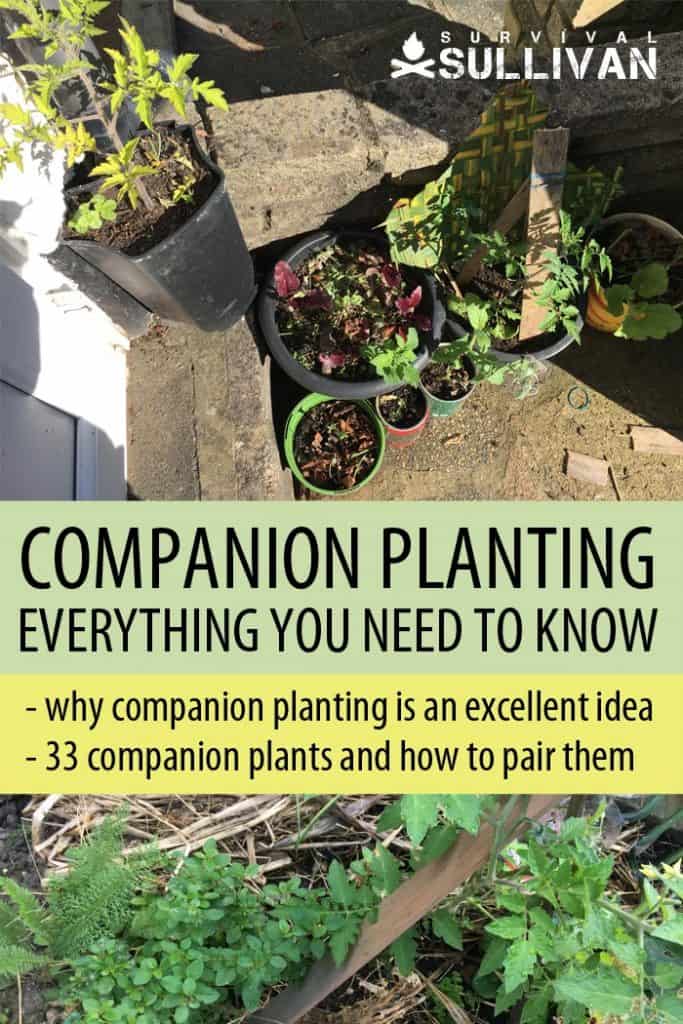When you are planning your garden, imagining it full of wonderful produce, herbs, and ornamental plants, it is so much fun to decide where you will put everything.
But does it really matter where you put the various plants? Have you ever considered that certain plants have preferred locations, and I don’t just mean somewhere sunny, with well-drained soil?
Have you ever considered that some plants grow better when they are near each other and that there are some plants that really dislike each other?
This is the nature of what is known as companion planting. Essentially, companion planting is the act of growing specific plants near each other to enhance growth and keep away pests.
In fact, it is truly amazing how nature has made some plants work so well together and it is even more amazing how you can use this plant recipe nature has conjured up to have a garden that is overflowing with goodness.
Table of Contents
Why Companion Planting?
Have you ever heard of permaculture? Permaculture is essentially the development of your immediate environment to create a self-sustaining ecosystem that will support the people that live there, providing shelter, water, food, and all other necessities of life.
The concept of permaculture is based on living in harmony with nature and ensuring that everything within the environment lives in harmony with every other thing in the environment. Some aspects of permaculture include:
- The use of waste in all its forms to help sustain the ecosystem and reduce the need to bring in nutrients from outside the system
- The creation of healthy, nutrient-rich soil
- The creation of a closed cycle of water and nutrient production and use
- Living in harmony with the environment and local communities
When it comes to food production, the key to keeping with a permaculture setup is to try to plant plants that are not only beautiful, but also functional.
You can plant raspberry or blackberry bushes, instead of a regular flowering hedge. You can plant bamboo that will flourish and that will also act as poles for climbing plants like pole beans. The key is to use plants that are:
- Practical
- Perennial when possible, to ensure a well-established plant that will continue to mature and provide sustenance year-after-year with minimal upkeep
- Able to provide food, medicine, or are beneficial in some other way
- Native to your region as much as possible
- More drought resistant or that can be planted in combination with other plants in such a way as to minimize watering needs
When developing your gardens in terms of a permaculture evironment, it is important to follow these tips:
- Consider how nature, such as a forest or meadow setting, tends to lay out plants and try to mimic this type of setup when planning your garden. Taller plants, such as trees, will give way to smaller trees and bushes, which will eventually give way to smaller plants.
- Look closely at your yard or garden space and get an idea of the natural layout of it, where it is shadier, where it is sunnier, etc. You can then plan your gardens in such a way that the plants in certain areas of your yard will be well adapted to the microclimate in which you plant them.
- Be sure to divide your yard into sections. You can determine which plants you will use more often and plant those in the more easily accessible sections of the yard. Therefore, you might want your herb garden closer to the house and your berry bushes and fruit trees further away.
- Assign each of your plants to a plant guild, which is a group of plants that are compatible with each other and grow well in each other’s company. Companion planting is an aspect of creating guilds that will ensure that you plant your fruits, vegetables, and herbs in such a way that plants that like each other and help each other will be together and plants that are harmful to one another will be seaprated. It is this companion planting that will be the focus of the rest of this article.
How Companion Planting Works
You might wonder how plants can help each other, but there are a number of reasons some plants are best planted next to other plants.
Whether you are planting a garden on an acre of land or you have a 10 x 10 foot space in which you practice square-foot gardening, the right plant combinations will help your garden flourish. Companion plants can do the following for each other:
- Tall plants provide shade for smaller, shade-living plants.
- Wide-leaved plants, such as squash, provide shade that keeps weeds from growing.
- Many tall plants and vines happily share the same area of ground, the vines growing up the stalk of the taller plant.
- Some plants contribute to the nutritional needs of other plants.
- Some plants repel pests or mask the scent of other plants to keep pests away from them.
- Some plants draw pests away from more sensitive plants.
- Some plants attract the natural predators of the pests of other plants.
- Mixing flowers and herbs in with your vegetables helps deter pests.
33 Companion Plants You Should Plant
At this point you might be wondering what plants work well together. It is true that the best gardens aren’t the ones in which seeds have been just thrown in the ground haphazardly, but the ones that have been carefully planned so that certain plants are put in certain places.
There are plants that are best planted near each other. The flip side of the companion planting coin offers up the plants that simply do not like to be planted next to each other. There are some plants that really just don’t like certain plants.
With that in mind, here is a list of vegetables and fruits, including what they should and shouldn’t be planted, as well as important information.
Asparagus
Companion: Carrots, tomatoes, dill, parsley, basil, coriander, and marigolds
Enemy: Onions, garlic, and potatoes
Tips: Tomatoes, parsley, and marigolds repel the asparagus beetle.
Basil
Companion: Nearly all plants
Enemy: Rue
Tips: Is effective at improving the flavor of all foods, particularly lettuce and tomatoes, and is a great mosquito repellent.
Beans
Companion: Corn, brassicas, cucumber, beets (only for bush beans), celery, eggplant, peas, potatoes, carrots, strawberries, and radishes
Enemy: Alliums (onion, garlic, chives, leeks), peppers, and tomatoes
Tips: Corn acts as a natural trellis for pole and runner beans and beans contribute nitrogen to the soil.
Beets
Companion: Brassicas, onion, garlic, lettuce, sage
Enemy: Beans (pole and runner varieties)
Tips: Beets and beans are too competitive and will result in stunted growth of both plants.
Borage
Companion: Tomatoes, squash, and strawberries
Tips: Acts to improve the flavor of nearby plants and deters tomato worms.
Brassicas
Companion: Bush beans, cucumber, dill, lettuce, onion, garlic, radishes, potatoes, marigolds, mint, sage, rosemary, thyme
Enemy: Strawberries, tomatoes, grapes, mustard, oregano
Tips: Dill attracts wasps, which control pests, and rosemary is a natural repellent for the cabbage fly. Dill also encourages the growth of cabbage and improves the cabbage’s flavor.
Cantaloupe
Companion: Corn
Carrots
Companion: Beans, onion, garlic, peas, tomatoes, lettuce, radishes, rosemary, and parsley
Enemy: Dill and parsnip
Tips: Beans introduce nitrogen into the soil, which is critical for carrots, and onion, parsley, and rosemary act as a natural repellent for the carrot fly. Dill will stunt the growth of carrots.
Celery
Companion: Bush beans, brassicas, leeks, garlic, chives, tomatoes, dill, nasturtiums, and marjoram
Enemy: Potatoes and parsnip
Tips: Garlic and chives work to deter aphids and nasturtiums also deter aphids and other pests.
Chives
Companion: Carrots, peas, tomatoes, berries, grapes, apples, and roses
Tips: Good deterrent for Japanese beetles and aphids and will enhance the growth and flavor of nearby plants.
Corn
Companion: Beans, peas, cucumber, potatoes, all squash, zucchini, melons, parsnip, marjoram, marigold, geranium, pigweed
Enemy: Tomatoes
Tips: Corn acts as a natural trellis for pole and runner beans and beans contribute nitrogen to the soil. Corn earworms and tomato worms will attack both plants.
Use marigold (odorless) and white geraniums to keep Japanese beetles away and pigweed to bring nutrients up in the soil to a level at which corn can access it.
Cucumber
Companion: Beans, brassicas, corn, tomatoes, celery, peas, radishes, lettuce, dill, and marigold
Enemy: Late potatoes and cilantro
Tips: Radishes are great for keeping cucumber beetles at bay. Potatoes and sage stunt the growth of cucumbers and cucumbers can cause blight in late potatoes.
Dill
Companion: Brassicas, onions, lettuce, and cucumber
Enemy: Carrots
Tips: Good at enhancing the growth and flavor of brassicas.
Eggplant
Companion: Beans, potatoes, peppers, tomatoes, and marjoram
Tips: Green beans are particularly good at keeping away Colorado beetles.
Garlic
Companion: Brassicas, tomatoes, cane fruit, fruit trees, and roses
Enemy: Beans and peas
Tips: A good deterrent for Japanese beetles and aphids, and when garlic oil is sprayed on vegetables, it deters onion flies, ermine moths, and aphids. A tea made from garlic can deter potato blight.
Leek
Companion: Celery, carrots, onions, lettuce
Enemy: Peas and beans
Tips: A natural repellent for the carrot fly, aphids, and other pests.
Lettuce
Companion: Beets, carrots, beans, corn, peas, onions, radishes, marigolds, mint, and strawberries
Enemy: Parsley and brassicas
Tips: Mint is a natural repellent for slugs, which love to feed on lettuce. Lettuce will soften radishes.
Marigolds
Companion: All plants
Tips: Acts as a stimulant for the growth of all vegetables and as a deterrent for many types of pests, such as beetles, nematodes, aphids, and potato bugs.
Marjoram
Companion: All plants
Tips: Marjoram acts as a stimulant for the growth of all vegetables.
Onion
Companion: Brassicas, beets, lettuce, tomatoes, strawberries, carrots, savory, rosemary, and marjoram
Enemy: Peas and beans
Tips: A natural repellent for the carrot fly, aphids, and other pests, including maggots.
Parsnips
Companion: Onions, wormwood, and radishes
Tips: Root maggots are deterred by onion and wormwood.
Peas
Companion: Cabbage, beans, corn, celery, potatoes, parsnip, cucumber, carrots, lettuce, sage, and marjoram
Enemy: All alliums
Peppers
Companion: Carrots, eggplant, onions, tomatoes, parsley, and basil
Enemy: Fennel and kohlrabi
Potato
Companion: Brassicas, corn, eggplant, beans, squash (except pumpkin), parsnip, horseradish, basil, and marjoram
Enemy: Cucumber, pumpkin, celery, raspberries, tomatoes, raspberries, sunflowers, and rosemary
Tips: Horseradish improves the potatoes’ resistance to disease and basil repels the potato beetle. Tomatoes, cucumbers, and raspberries attract pests that are harmful to potatoes.
Pumpkin
Companion: Corn, beans, and radishes
Enemy: Potatoes
Radish
Companion: Corn, cucumber, cabbage, peas, eggplant, lettuce, root vegetables, parsnip, nasturtiums, and marjoram
Tips: Radishes are great at keeping some pests, such as flea and cucumber beetles, away from other plants. Nasturtiums add flavor to radishes.
Rosemary
Companion: Brassicas, beans, and carrots
Tips: Acts as a great deterrent for carrot flies, beetles, and cabbage moths.
Spinach
Companion: Peas, lettuce, beans, and strawberries
Tips: Spinach likes the shade that peas and beans offer.
Squash
Companion: Strawberries and fruit trees
Tips:
Strawberries
Companion: Bush beans, spinach, lettuce, borage, and caraway
Enemy: Brassicas
Tomato
Companion: Alliums, carrots, peppers, broccoli, cauliflower, celery, asparagus, basil, marigolds, borage
Enemy: Beets, brassicas, potatoes, corn, peas, fennel, rosemary, cilantro, and dill
Tips: Basil is particularly good at increasing the yield from tomato plants when it is grown roughly 10 inches from the tomatoes.
Turnip
Companion: Peas
Enemy: Mustard and knotweed
Tips: Mustard and knotweed will stunt the growth of turnips.
Zucchini
Companion: Any flowering herbs
Tip: Flowering herbs help increase pollination.
This gives you a good start to companion (and enemy) planting. You know what plants to put next to each other and what you need to keep separate. However, it is important to understand that companion planting is not an exact science.
You will see different information in different places, which means that there will be some need to test the waters when experimenting with companion planting.
Final Word
When planning your garden, take the time to draw it out on paper, decide what you want to grow, and find just the right place for each vegetable and fruit.
Consider the permaculture approach and try to mimic the natural environment as much as possible. This way you know that every member of your garden will like their neighbors and will be very happy and you will create a balanced, natural environment in which your garden and nature will thrive together.


An urban prepper and rural wannabe, Karen has been working as a freelance writer for a decade and prepping for about half that time. She has gathered a wealth of knowledge on preparing for SHTF, but there is always more to learn and she has a passion for gathering and sharing that knowledge with other like-minded folk. Karen lives in London, Canada with her two children and plethora of cats.

Awesome information as usual! Thank you so very much!
Great information, Dan. Thanks very much.
My mother and I are just starting to do this.
This information is very helpful to a complete novice like myself.